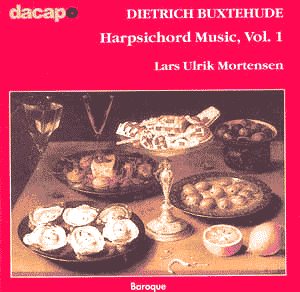Dietrich BUXTEHUDE
(1637-1707)
Harpsichord Music Vol. 1
Toccata in G Major [5.14]
Wie schön leuchet der Morgenstern [8.07]
Suite in D minor [9.28]
Fuga in B Flat Major [4.10]
Suite in C Major [9.02]
Aria in A minor [5.37]
Canzona in C Major [4.09]
Partita Auf meinen lieben Gott in E minor [4.37]
Canzonetta in A minor [1.34]
 Lars Ulrik Mortensen,
harpsichord Lars Ulrik Mortensen,
harpsichord
Rec: September 1998
 DA CAPO
8.224116
[51.58] DA CAPO
8.224116
[51.58] |
 |
| Crotchet
AmazonUK
AmazonUS
Amazon
recommendations |
Dietrich Buxtehude was a Danish composer later naturalized German who spent
most of his life in Lübeck. He wrote a wide variety of music - from
beautiful works for harpsichord, to masterpieces for organ, by way of vocal
music. He also started a series of concerts, separate from church services,
called 'Abendmusik' (Evening music), to provide musical entertainment for
the town's bourgeoisie.
Da Capo has, so far, released 3 CDs of Buxtehude's harpsichord works, all
performed excellently by Lars Ulrik Mortensen. This is the first volume of
this series.
First of all, some general notes about the series. Mortensen is a fine performer,
playing these works with passion and verve. He clearly wants to show just
how rich and delightful this music is. His touch is just and precise, and
he uses all of the instrument's capacities, offering a full range of sounds
through its various stops and registers. He plays a beautifully sounding
Ruckers copy by Thomas Mandrup-Poulsen, which is tuned to a mean-tone
temperament. (Mean-tone temperament, a type of tuning used in Buxtehude's
lifetime, entailed tuning the instrument so that certain keys are tuned
perfectly, but, as a result of this, other keys are unplayable. The purity
of the "good" keys is much more precise, but this leaves certain notes (sharps
and flats) sounding "out of tune".) It should be noted that some of the works
on these recordings were originally written for organ; Mortensen has decided
to include some of these pieces that are playable on the harpsichord.
The music on this disc covers a full range of Buxtehude's compositional styles
for the keyboard. It opens with a Toccata, which is a brilliant work showing
Buxtehude's more impetuous nature. In this piece, at just over 5 minutes,
Buxtehude shows a wide variety of keyboard techniques and styles, from a
flamboyant opening, through a brief passage of ostinato variations, reminiscent
of Pachelbel's canon.
The second work is a curiosity. Wie schön leuchet der Morgenstern is
a choral setting, featuring several variations on the main theme. It is broken
into several distinct sections, and there is a striking similarity between
parts of this work and several of the variations in Bach's Goldberg Variations.
In particular, about 2½ minutes into the piece is a brief section that
is very similar to Bach's variation 26. This work shows, in 8 minutes, a
wide variety of styles and forms, and is a perfect example of Buxtehude's
compositional repertory. Curiously, although this was written for organ,
the harpsichord allows better expression of its subtlety. Comparing it with
an organ recording (Olivier Vernet, Ligia Digital), I find that the organ
stifles some of the subtle effects that the harpsichord highlights perfectly.
The two suites on this recording, the D minor and C major suites, are beautiful
works in the French style. Buxtehude's suites differ from those of later
baroque composers. Each containing only four movements (allemande, courante,
sarabande and gigue), they are all based on the themes presented in the
allemande. This gives them a more restrained tone than suites by other composers,
such as Froberger or Bach. There are no flamboyant preludes to open these
suites, but rather more introspective allemandes, full of melodies and emotion.
The suites all have a slow-fast-slow-fast construction, and their French
sound recalls that of Louis Couperin, in their subtle melodies and balanced
ornamentation.
Another work worth noting on this disc is the Aria in A minor. Buxtehude
liked works with variations. What he called an aria, for keyboard, was a
piece containing an initial exposition and several variations. This aria
is short, with only 3 parts, but it foreshadows his great aria La Capricciosa,
with its 30 variations. This piece begins with a slow, almost melancholy
movement, the second variation is a subtler restating of the initial tone,
but the final variation is a toccata-like piece with great energy.
Closing this disc is a beautiful little work, the Canzonetta in A minor.
Just over 1 1/2 minutes long, this remarkable piece, written for organ, uses
the very highest notes on the keyboard, as it zips through virtuosic runs
at breakneck speed. A perfect closing piece for this excellent selection
of Buxtehude's keyboard works.
An amazing recording, containing some beautiful harpsichord music by a composer
who deserves to be better-known. Excellently performed, perfectly recorded,
and played on a delightful instrument, I could not recommend this with more
enthusiasm.
Kirk McElhearn

